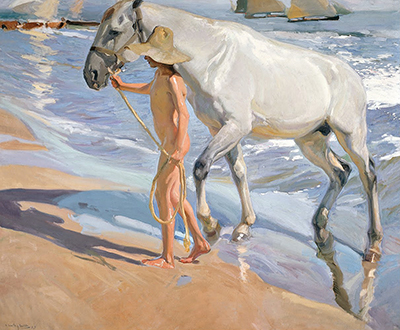The Horse's Bath is one of Joaquin Sorolla's best pieces. He composed the painting in 1909 and maintained its possession until his death. Currently, the painting is showcased in the Sorolla Museum collection in Madrid. The composition is drawn on a 205cm (height) by 250 cm (width) canvas using the oil technique.
Like most of his work, the image on this painting features scenes from the El Cabanal Beach in Valencia. Valencia was the hometown of Joaquin Sorolla and has also been featured in pieces like the women on the beach and sad inheritance. The painting features two main subjects, which are a boy who appears to be in his youth and a horse. In the painting, a naked boy on the side is seen leading a white horse on the sandy beach out of the seawater. The boy, who is completely naked from the neck down, wears a large straw hat on his head, probably to shield himself from the sun. His skin glistens in a manner that suggests he is still wet from the seawater. From his arms to his legs, Sorolla does not fail to detail the slim silhouette of the youth. With both his hands, the boy holds on to a rope with which the Horse is tied. Unlike the Horse, the youth's feet are touching the sand and completely away from the water. On the beach's sand and partly on the water are the shadows of the boy and the Horse.
On the other hand, the White Horse, which also appears to be sparkling from the wetness of the seawater, is walking out of the water with the guidance of the boy. The Horse appears very calm, and Sorolla masterfully captures the movement of the two. In the background, there are a few boats on the sea. Most of the painting consists of the sparkling blue sea, whose waters appear unsettled. The entire scene is bathed in sunlight in such a way that the viewer can almost feel the sun. The shoreline is full of visual effects. It features the brilliant bodies of wet skin, sheets of water that make the sand appear as a mirror and reflections of light on the unsettled water as well as the shadows.
The point of view of Horse's Bath is above the height of the boy in the scene. This means that Sorolla was more interested in what was happening on the grown than in the sky since there is no feature of the sky on this composition. However, the focus appears to incline to center the attention of the spectators, and the gaze seems to be trapped on the surface of the canvas. At the start of his career, Sorolla focused his compositions on themes like social awareness. However, this wasn't a lasting move because he soon moved towards lighter subjects drawing his inspiration from his family and surroundings. Sorolla owned a beach house on the Mediterranean shore in Valencia. From the views he experienced on the beach, he based most of his work. He drew his inspiration from the dazzling light, shade, and the brilliant colors on the seashore.
Joaquin also often painted his family. For instance, the painting of women on the beach depicts his wife and eldest daughter. This is just one of the several paintings where he featured his wife, two daughters, and son. The Museo Sorolla was initially his home with his wife and kids, which was turned into a museum after the death of his wife. The family turned over his estate and all his compositions to the Spanish government. The state decided to showcase the pieces in the Museo Sorolla.




